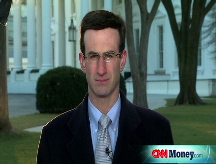Obama's deficit goal: Hurdles ahead
Reducing the deficit in good times isn't easy or popular. Doing it while trying to put out other fires will present quite a challenge.


NEW YORK (CNNMoney.com) -- President Obama has set a very public and very tough challenge for himself: To cut the annual 2013 deficit in half.
It won't be easy.
Obama's goal would produce a deficit that's still higher than the deficit of $455 billion in 2008, but it's far less than the $1 trillion-plus deficits that budget experts are projecting for each of the next several years if nothing changes.
"This administration has inherited a $1.3 trillion deficit -- the largest in our nation's history -- and our investments to rescue our economy will add to that deficit in the short term," Obama said Monday. "[T]oday I'm pledging to cut the deficit we inherited in half by the end of my first term in office."
Every bit will help. The United States currently has an accumulated debt load of $10.8 trillion. Of that amount, $6.5 trillion is debt owed to the public, meaning those who buy government bonds such as individuals, banks and foreign countries. The rest primarily reflects what the Treasury owes to the Social Security system, having borrowed the surplus workers pay into that system in recent years.
And the $10.8 trillion debt doesn't yet reflect the increase to the deficit as a result of expected tax policy changes or the $787 billion economic stimulus plan just signed into law.
Every year that the federal government runs a deficit -- that is, spends more than it takes in -- the accumulated debt for the country rises.
Given how quickly the long-term debt has been rising, lawmakers included a provision in the economic recovery package that raises the national debt ceiling to $12.1 trillion, up from $11.3 trillion.
The ceiling is a cap on how much Treasury can spend. But it's a cap that can be moved if lawmakers choose. In fact, they've already raised the ceiling twice for fiscal year 2009 alone.
That isn't surprising given the outsized problems hurting the economy and the financial system. But it's specifically those problems that could thwart Obama's best intentions to cut the annual deficit by the end of his term.
"It's a very tall order," said Charles Konigsberg, a former assistant director at OMB in the Clinton administration and now chief budget counsel at the Concord Coalition, a deficit watchdog group.
The exact details on how the president plans to reduce the deficit will be made much clearer Thursday when he submits to Congress an outline of his budget request for fiscal year 2010. But he and his budget director, Peter Orszag, have already indicated what a few of their proposals will be:
- let the 2001 and 2003 tax cuts expire for families making more than $250,000, although not this year;
- reduce spending on the Iraq war by withdrawing troops;
- reduce health care costs by creating more efficiencies in the system;
- end payments to agribusiness that don't need them;
- end tax breaks for companies shipping jobs overseas;
- stop fraud and abuse in Medicare; and
- insist on pay-go rules, which requires lawmakers to either raise revenue or cut spending to accommodate new spending measures.
But even if they're able to achieve those objectives flawlessly -- and each one is politically difficult to accomplish -- there are still some big unknowns that could thwart their best efforts.
The government has undertaken numerous efforts simultaneously to keep banks, car makers and housing giants Fannie Mae and Freddie Mac solvent and adequately capitalized. What more needs to be done and how much it will cost are among the big questions.
The Treasury has already been granted $700 billion to stabilize the financial system, housing and the auto industry. And it's committed half of that to date.
Treasury Secretary Tim Geithner has offered an outline but not many details on his plans for the remainder of the $700 billion -- part of which will be to encourage hedge funds and other investors to share in the cost of helping get bad assets off the books of banks and other financial service companies. Doing so is estimated to cost from $500 billion to more than $1 trillion. It's not clear whether private investors will participate and to what degree.
In addition, the government is backing hundreds of billions in loan losses from Citibank (C, Fortune 500) and Bank of America (BAC, Fortune 500). It's not clear if or the extent to which that insurance will ever be used.
Its efforts to help Detroit are still a work in progress. Saving General Motors (GM, Fortune 500), Chrysler LLC and the auto suppliers and dealers that depend on them could cost $130 billion or more.
Proponents of the $787 billion economic recovery package said it's necessary to stem the downturn. But even Obama's economic team has made it clear the plan won't restore the economy to full employment within two years or boost productivity to high levels.
Given that the economy is expected to produce $2 trillion less than its capacity this year and next, some economists believe the economy might need another round of stimulus.
"Nobody knows how much if any more will be needed for economic stimulus," Konigsberg said. "Nobody really knows the answer to that."
Have you found a job recently? We want to hear from you. Send us an email and attach a photo. Tell us where you got hired and how you landed the job and you could be profiled in an upcoming story on CNNMoney.com. ![]()



